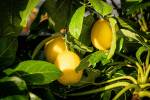Sand eliminates pesky fungus gnats from plants
I can sure tell it is spring with all the questions coming my way. Here are my answers:
Q: What are the tiny bugs fluttering around my house and near my houseplants?
A: You have fungus gnats. They breed in the organic matter found in the root media of your houseplants. Cover the soil surface with a half-inch of sand and eliminate their breeding area.
Q: I planted irises for the first time last year and want to know what to do with them. They are shabby looking.
A: Remove dead growth but keep the greenery. Your blooms have yet to come, and they need those leaves to produce their food. According to Hiro Uyeda of the Las Vegas Iris Society, it's time to feed them.
Q: Can I move my iris plants now?
A: Yes, but why? They are about to bloom, and moving them may sacrifice this year's flowers.
Q: What is the best apricot tree to plant in Las Vegas?
A: According to my favorite book, "Becoming a Desert Gardener," the cooperative extension recommends Royal, Gold Kist, Katy and Moorpark.
Q: How do I prune my bird of paradise as it froze back?
A: Prune after the frost. Cut stems back to 6 to 10 inches above the ground for complete renewal. Expect a surge of growth when temperatures warm. Seedpods can be messy, so remove them as they develop. Because it is a legume, it is a self-feeder.
Q: How do I prune my chaste tree?
A: About all that is required is to thin out interior growth, but don't overdo it. If seedpods bother you, do what we call deadheading, removing them after blooming ceases.
Q: Can I compost my cactus plants?
A: Dave Turner of Turner Greenhouses says cactuses themselves will make good compost, but keep them buried to prevent sprouting. He is more concerned about thorns breaking down, because they decay very slowly. Be careful when working the pile.
Q: Can we grow pussy willows in Las Vegas?
A: They do grow here, but they require lots of water to keep them performing. They thrive when grown in an organic-based soil. You don't have to prune them much, but do it after blooming because they flower on the previous season's growth. About every three years, cut them back to a 6-inch stump.
Q: My bougainvillea needs pruning. Do I cut it back to the ground, and when do I do it?
A: If it froze back, remove affected branches back to live wood when buds break this spring. But let's be positive and hope it didn't. Do not prune until after bloom, or you'll remove the flowering wood. Through the summer, nip back extending branches to keep them in check. If you have a lot of rapid growth, it is a good indication you're overwatering. Don't fertilize after Labor Day, because later feedings produce very tender growth that will easily freeze next winter.
Q: When do I prune my crape myrtle?
A: You prune this plant before bloom, as it blooms in summer, which is opposite to pruning bougainvilleas. Cut back into the plant at least a foot to remove spent flowers and rejuvenate the plant. Then feed it. This will improve flowering and certainly add to its beauty this summer.
Q: I saw artificial grass in the amphitheater at the Springs Preserve. Is it a likely alternative to a live lawn in Southern Nevada and, if so, where I can purchase it?
A: Artificial turf is a workable option for landscapes. You'll find suppliers in the Yellow Pages under "golf course construction." If they make turf, they also offer putting greens, a wonderful addition for golf lovers and, of course, they don't use any water.
Q: Are pyracantha berries poisonous to dogs?
A: The berries are not a problem. The late Aggie Roberts made pyracantha jam that I enjoyed.
Q: Is there a place to buy glass mulch locally?
A: Amy Zeldenrust, a master gardener, informs me Vista Landscape Supply Center, 951 Wigwam Parkway in Henderson, has several kinds to choose from.
Q: We want a tree for the north side of our home. Pines, mesquites and paloverdes have been suggested. Are they good choices, or are others better?
A: I suggest picking up a copy of "Trees for Tomorrow" at your nursery or go to www.nevadagardens.com. Here, you will find a list of small, medium and large trees. It also provides information about their dimensions, when they flower, whether they are deciduous or evergreen, slow, moderate or fast growing, water needs, if they are a litter problem, landscape uses, and a short description and photo of each tree.
LEARNING OPPORTUNITIES
Garden tour: Does your back ache to the point you have given up on gardening? Do you only have a patio in an apartment complex and want to garden? Let the Springs Preserve show you how to turn these challenges into simple and joyful solutions.
Tomatoes! Tomatoes! Tomatoes!: Did you know there's more than one way to grow tomatoes?
Do you want to learn the ins, outs and upside downs of growing tomatoes?
Have you tried green tomatoes in your diet?
Do you want to add a little salsa to your life?
The answers to these and more of your questions will be sliced to perfection at this informative seminar. Join Helen Brown, Don Fabbi and me at 8:30 a.m. Saturday at the beautiful Springs Preserve, 333 S. Valley View Blvd. To reserve your seat, call 822-7786.
Growing vegetables hydroponically in a greenhouse: The cooperative extension staff will show you how a greenhouse enables you to have fresh vegetables year-round at 7 p.m. Tuesday.
Roses -- now and in the future: Join Christian Bedard, much acclaimed for his new miniature rose release, Coffee Bean from Weeks Roses, at 7 p.m. Thursday as he tells about new rose releases and the roses that do best here.
Hydroponic gardening and growing roses are at the Cooperative Extension Lifelong Learning Center, 8050 S. Maryland Parkway.
Gardening lecture series: The following lectures are co-sponsored by the College of Southern Nevada and University of Nevada, Las Vegas. Fruit & Veggie Gardening, Saturday; Landscaping Your Yard, March 15-16; Cactus & Succulents, March 29-30. The series is at the Barrick Museum on the UNLV campus, 4505 S. Maryland Parkway.
Linn Mills writes a garden column every Sunday. You can reach him at linn.mills@springspreserve.org or at the Gardens at the Springs Preserve at 822-7754.























